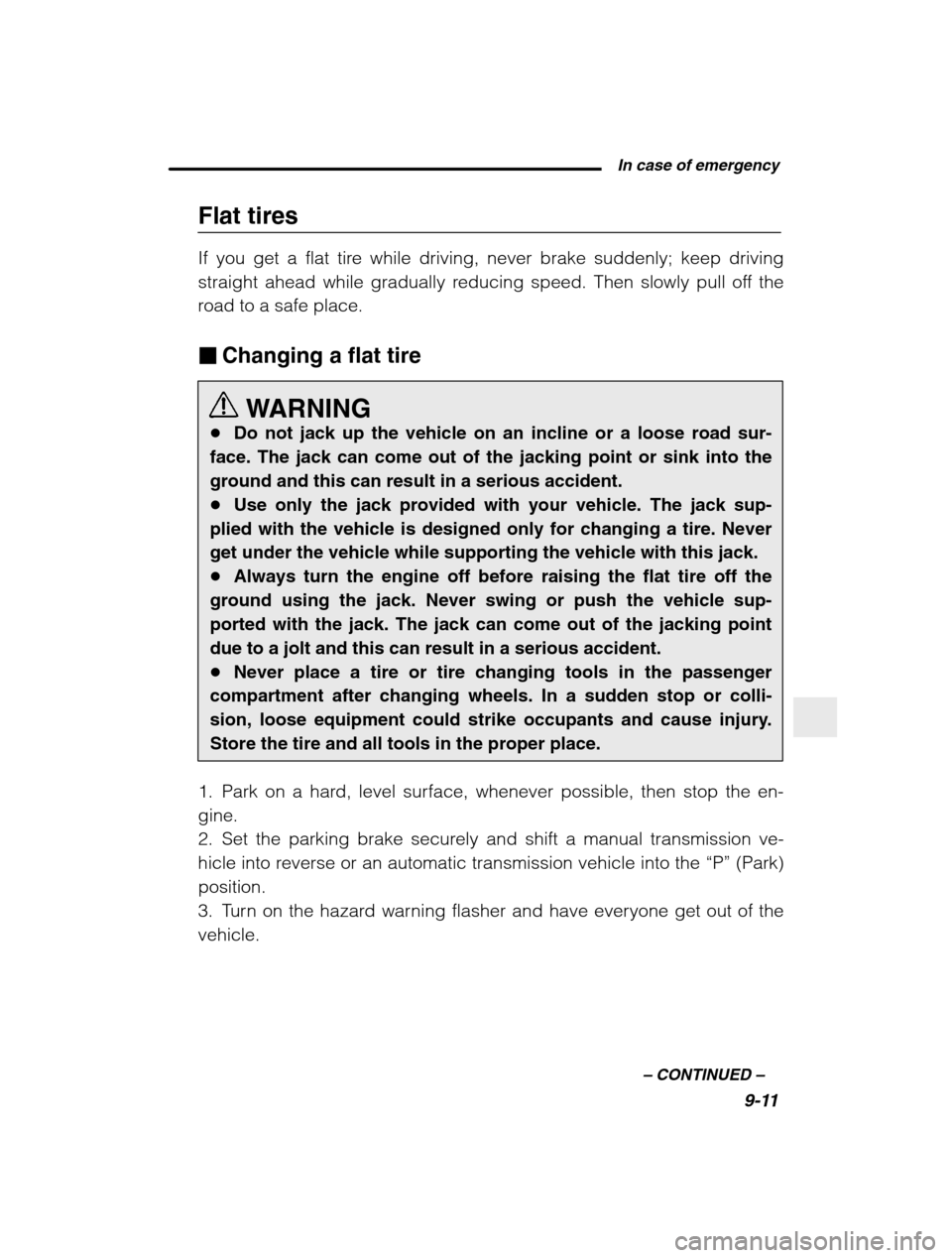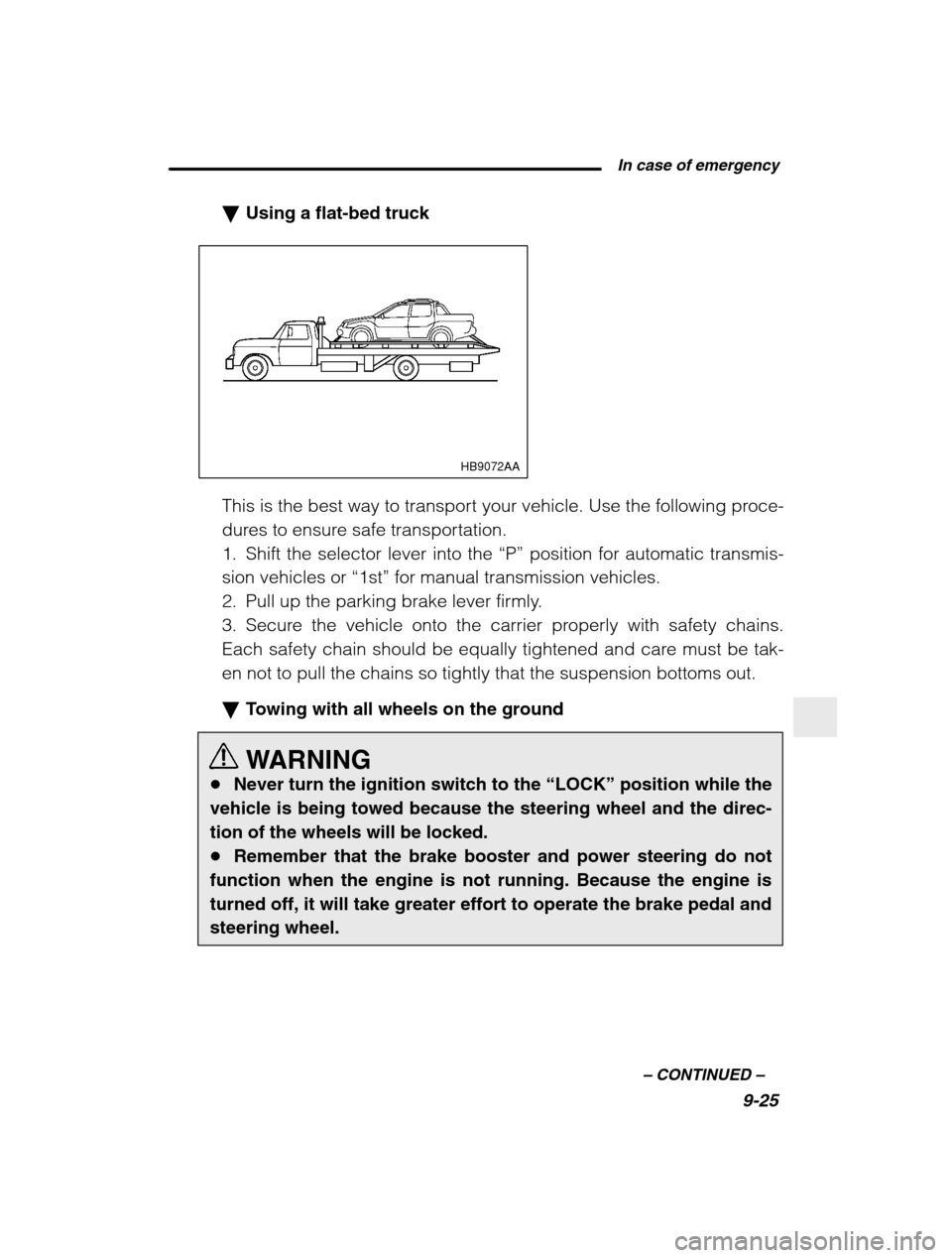2003 SUBARU BAJA parking brake
[x] Cancel search: parking brakePage 269 of 400

Driving tips8-31
–
CONTINUED –
cient slack in the chains taking tight-turn situations into account; how-
ever, be careful not to let them drag on the ground.
For more information about the safety chain connection, refer to the
instructions for your hitch and trailer. nSide mirrors
After hitching a trailer to your vehicle, check that the standard side
mirrors provide a good rearward field of view without significant blindspots. If significant blind spots occur with the vehicle ’s standard side
mirrors, use towing mirrors that conform with Federal, state/province
and/or other applicable regulations.
HB8041BA
n Trailer lights CAUTION
Direct splicing or other improper connection of trailer lights may
damage your vehicle ’s electrical system and cause a malfunction
of your vehicle ’s lighting system.
Connection of trailer lights to your vehicle ’s electrical system requires
modifications to the vehicle ’s lighting circuit to increase its capacity
and accommodate wiring changes. To ensure the trailer lights are
connected properly, please consult your SUBARU dealer. Check for
proper operation of the turn signals, the brake lights and parkinglights each time you hitch up.
Page 273 of 400

Driving tips8-35
–
CONTINUED –
gauge pointer approaches the OVERHEAT zone or the AT OIL TEMP
warning light illuminates, immediately switch off the air conditioner
and stop the vehicle at the nearest safe place. Refer to the “Engine
overheat” section in Chapter 9, and “Warning and indicator lights ”
section in Chapter 3.� If your vehicle has an automatic transmission, avoid using the
accelerator pedal to stay stationary on an uphill slope instead of usingthe parking brake or foot brake. That may cause the transmission fluidto overheat. Also, if your vehicle is equipped with an automatic trans-mission, avoid driving with the gear selector lever in “D” when towing
a heavy trailer to prevent fluid overheating. A lower gear should beused. n Parking on a grade
Always block the wheels under both vehicle and trailer when parking.
Apply the parking brake firmly. You should not park on a hill or slope.But if parking on a hill or slope cannot be avoided, you should takethe following steps:
1. Apply the brakes and hold the pedal down.
2. Have someone place wheel blocks under both the vehicle and
trailer wheels.
3. When the wheel blocks are in place, release the regular brakes
slowly until the blocks absorb the load.
4. Apply the regular brakes and then apply the parking brake; slowly
release the regular brakes.
5. Shift into 1st or reverse gear (manual transmission) or “P” (auto-
matic transmission) and shut off the engine.
Page 285 of 400

In case of emergency9-11
–
CONTINUED –
Flat tires
If you get a flat tire while driving, never brake suddenly; keep driving
straight ahead while gradually reducing speed. Then slowly pull off the
road to a safe place. �Changing a flat tire
WARNING
� Do not jack up the vehicle on an incline or a loose road sur-
face. The jack can come out of the jacking point or sink into the ground and this can result in a serious accident.� Use only the jack provided with your vehicle. The jack sup-
plied with the vehicle is designed only for changing a tire. Neverget under the vehicle while supporting the vehicle with this jack.� Always turn the engine off before raising the flat tire off the
ground using the jack. Never swing or push the vehicle sup-ported with the jack. The jack can come out of the jacking pointdue to a jolt and this can result in a serious accident.� Never place a tire or tire changing tools in the passenger
compartment after changing wheels. In a sudden stop or colli-
sion, loose equipment could strike occupants and cause injury.Store the tire and all tools in the proper place.
1. Park on a hard, level surface, whenever possible, then stop the en-gine.
2. Set the parking brake securely and shift a manual transmission ve-
hicle into reverse or an automatic transmission vehicle into the “P” (Park)
position.
3. Turn on the hazard warning flasher and have everyone get out of thevehicle.
Page 299 of 400

In case of emergency9-25
–
CONTINUED –
�Using a flat-bed truck
HB9072AA
This is the best way to transport your vehicle. Use the following proce-
dures to ensure safe transportation.
1. Shift the selector lever into the “P” position for automatic transmis-
sion vehicles or “1st” for manual transmission vehicles.
2. Pull up the parking brake lever firmly.
3. Secure the vehicle onto the carrier properly with safety chains.
Each safety chain should be equally tightened and care must be tak-en not to pull the chains so tightly that the suspension bottoms out. � Towing with all wheels on the ground
WARNING
� Never turn the ignition switch to the “LOCK” position while the
vehicle is being towed because the steering wheel and the direc- tion of the wheels will be locked.� Remember that the brake booster and power steering do not
function when the engine is not running. Because the engine isturned off, it will take greater effort to operate the brake pedal andsteering wheel.
Page 300 of 400

9-26
CAUTION
� If transmission failure occurs, transport your vehicle on a flat-
bed truck. � Do not run the engine while the vehicle is being towed using
this method. Transmission damage could result if the vehicle istowed with the engine running.� For vehicles with automatic transmission, the traveling speed
must be limited to less than 20 mph (30 km/h) and the traveling
distance to less than 30 miles (50 km). For greater speeds and
distances, transport your vehicle on a flat-bed truck.
HB9071AA
1. Check the transmission and differential oil levels and add oil to
bring it to the upper level if necessary.
2. Release the parking brake and put the transmission in neutral.
3. The ignition switch should be in the “ACC” position while the ve-
hicle is being towed.
4. Take up slack in the towline slowly to prevent damage to the ve-hicle.
Page 311 of 400

11
Maintenance and service
Maintenance schedule11-3
. . . . . . . . . . . . . . . . . . . . . . . . . . . . . . . . . . . . . . . . . . . . . . . . . .
Maintenance precautions 11-3
. . . . . . . . . . . . . . . . . . . . . . . . . . . . . . . . . . . . . . . . . . . . . .
Engine hood 11-5
. . . . . . . . . . . . . . . . . . . . . . . . . . . . . . . . . . . . . . . . . . . . . . . . . . . . . . . . . . . . . . . .
Engine compartment overview 11-7 . . . . . . . . . . . . . . . . . . . . . . . . . . . . . . . . . . . . . . .
Engine oil 11-8
. . . . . . . . . . . . . . . . . . . . . . . . . . . . . . . . . . . . . . . . . . . . . . . . . . . . . . . . . . . . . . . . . . . .
Cooling system 11-13
. . . . . . . . . . . . . . . . . . . . . . . . . . . . . . . . . . . . . . . . . . . . . . . . . . . . . . . . . . . .
Engine coolant 11-14
. . . . . . . . . . . . . . . . . . . . . . . . . . . . . . . . . . . . . . . . . . . . . . . . . . . . . . . . . . .
Air cleaner element 11-17
. . . . . . . . . . . . . . . . . . . . . . . . . . . . . . . . . . . . . . . . . . . . . . . . . . . . . .
Spark plugs 11-19
. . . . . . . . . . . . . . . . . . . . . . . . . . . . . . . . . . . . . . . . . . . . . . . . . . . . . . . . . . . . . . . . .
Drive belts 11-20
. . . . . . . . . . . . . . . . . . . . . . . . . . . . . . . . . . . . . . . . . . . . . . . . . . . . . . . . . . . . . . . . . . .
Manual transmission oil 11-21
. . . . . . . . . . . . . . . . . . . . . . . . . . . . . . . . . . . . . . . . . . . . . . . .
Automatic transmission fluid 11-22 . . . . . . . . . . . . . . . . . . . . . . . . . . . . . . . . . . . . . . . . .
Front differential gear oil (AT vehicles) 11-24 . . . . . . . . . . . . . . . . . . . . . . . . . . . .
Rear differential gear oil 11-25
. . . . . . . . . . . . . . . . . . . . . . . . . . . . . . . . . . . . . . . . . . . . . . . .
Power steering fluid 11-27
. . . . . . . . . . . . . . . . . . . . . . . . . . . . . . . . . . . . . . . . . . . . . . . . . . . . .
Brake fluid 11-28
. . . . . . . . . . . . . . . . . . . . . . . . . . . . . . . . . . . . . . . . . . . . . . . . . . . . . . . . . . . . . . . . . . .
Clutch fluid (MT vehicles) 11-30 . . . . . . . . . . . . . . . . . . . . . . . . . . . . . . . . . . . . . . . . . . . . . .
Brake booster 11-31
. . . . . . . . . . . . . . . . . . . . . . . . . . . . . . . . . . . . . . . . . . . . . . . . . . . . . . . . . . . . . .
Brake pedal 11-32
. . . . . . . . . . . . . . . . . . . . . . . . . . . . . . . . . . . . . . . . . . . . . . . . . . . . . . . . . . . . . . . . .
Clutch pedal (Manual transmission vehicles) 11-33 . . . . . . . . . . . . . . . . . . .
Replacement of brake pad and lining 11-34 . . . . . . . . . . . . . . . . . . . . . . . . . . . . . .
Parking brake stroke 11-35
. . . . . . . . . . . . . . . . . . . . . . . . . . . . . . . . . . . . . . . . . . . . . . . . . . . .
Tires and wheels 11-36
. . . . . . . . . . . . . . . . . . . . . . . . . . . . . . . . . . . . . . . . . . . . . . . . . . . . . . . . . .
Types of tires 11-36
. . . . . . . . . . . . . . . . . . . . . . . . . . . . . . . . . . . . . . . . . . . . . . . . . . . . . . . . . . . . .
Tire inspection 11-37
. . . . . . . . . . . . . . . . . . . . . . . . . . . . . . . . . . . . . . . . . . . . . . . . . . . . . . . . . . .
Tire pressures and wear 11-37
. . . . . . . . . . . . . . . . . . . . . . . . . . . . . . . . . . . . . . . . . . . . . . . .
Wheel balance 11-40
. . . . . . . . . . . . . . . . . . . . . . . . . . . . . . . . . . . . . . . . . . . . . . . . . . . . . . . . . . . .
Wear indicators 11-41
. . . . . . . . . . . . . . . . . . . . . . . . . . . . . . . . . . . . . . . . . . . . . . . . . . . . . . . . . .
Tire rotation 11-42
. . . . . . . . . . . . . . . . . . . . . . . . . . . . . . . . . . . . . . . . . . . . . . . . . . . . . . . . . . . . . . .
Tire replacement 11-42
. . . . . . . . . . . . . . . . . . . . . . . . . . . . . . . . . . . . . . . . . . . . . . . . . . . . . . . . .
Wheel replacement 11-43
. . . . . . . . . . . . . . . . . . . . . . . . . . . . . . . . . . . . . . . . . . . . . . . . . . . . . .
Aluminum wheels 11-44
. . . . . . . . . . . . . . . . . . . . . . . . . . . . . . . . . . . . . . . . . . . . . . . . . . . . . . . . .
Windshield washer fluid 11-44
. . . . . . . . . . . . . . . . . . . . . . . . . . . . . . . . . . . . . . . . . . . . . . . .
Replacement of windshield wiper blades 11-45 . . . . . . . . . . . . . . . . . . . . . . . .
Battery 11-48
. . . . . . . . . . . . . . . . . . . . . . . . . . . . . . . . . . . . . . . . . . . . . . . . . . . . . . . . . . . . . . . . . . . . . . . .
Page 314 of 400

11-4
�Always use the proper tools and make certain that they are
well maintained. � Never get under the vehicle supported only by a jack. Always
use a safety stands to support the vehicle.� Never keep the engine running in a poorly ventilated area,
such as a garage or other closed areas.� Do not smoke or allow open flames around the fuel or battery.
This will cause a fire.� Because the fuel system is under pressure, replacement of the
fuel filter should be performed only by your SUBARU dealer.� Wear adequate eye protection to guard against getting oil or
fluids in your eyes. If something does get in your eyes, thorough-
ly wash them out with clean water.� Do not tamper with the wiring of the SRS airbag system or
seatbelt pretensioner system, or attempt to take its connectorsapart, as that may activate the system or it can render it inopera-tive. The wiring and connectors of these systems are yellow for
easy identification. NEVER use a circuit tester for these wiring. If your SRS airbag or seatbelt pretensioner needs service, con-
sult your nearest SUBARU dealer. � Before checking or servicing in the engine compart- ment
� Always stop the engine and set the parking brake firmly to pre-
vent the vehicle from moving. � Always let the engine cool down. Engine parts become very
hot when the engine is running and remain hot for some time af-ter the engine is stopped.� Do not spill engine oil, engine coolant, brake fluid or any other
fluid on hot engine components. This may cause a fire.� Always remove the key from the ignition switch. When the
ignition switch is in the “ON” position, the cooling fan may oper-
ate suddenly even when the engine is stopped.
Page 332 of 400

11-22
SAE viscosity No. and Applicable Temperature
OM-H0205
Automatic transmission fluid�Checking the fluid level
The automatic transmission fluid expands largely as its temperature
rises; the fluid level differs according to fluid temperature. Therefore,
there are two different scales for checking the level of hot fluid andcold fluid on the dipstick.
Though the fluid level can be checked without warming up the fluid on the “COLD” range, we recommend checking the fluid level when
the fluid is at operating temperature. n Checking the fluid level when the fluid is hot
Check the fluid level monthly.
1. Drive the vehicle several miles to raise the temperature of the
transmission fluid up to normal operating temperature; 158 to 176 °F
(70 to 80 °C) is normal.
2. Park the vehicle on a level surface and set the parking brake.
3. First shift the selector lever in each position. Then shift it in the “P”
position, and run the engine at idling speed.